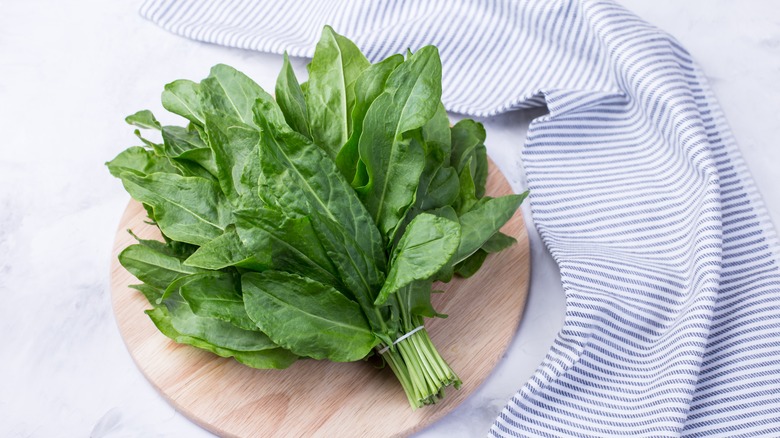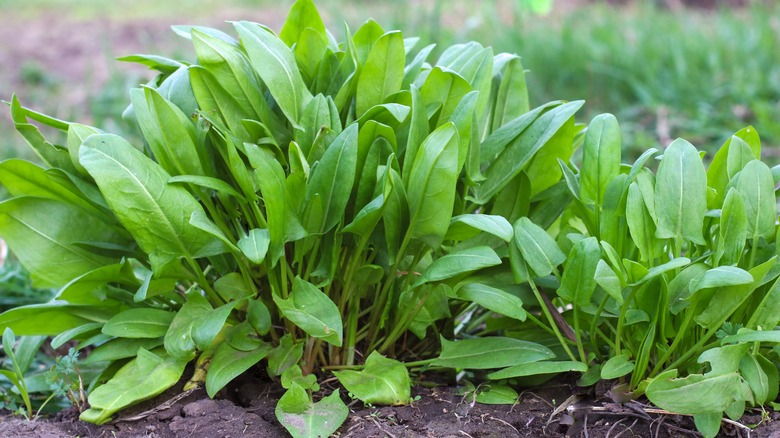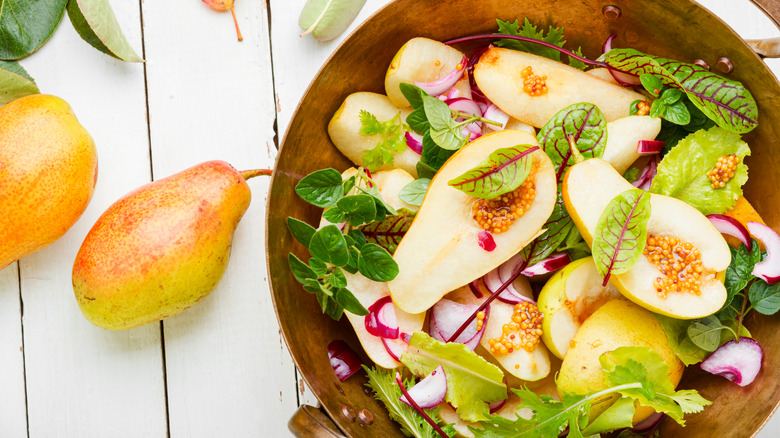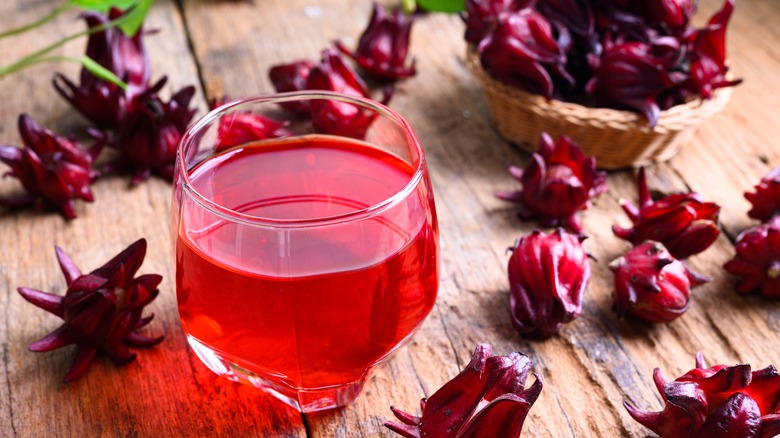What Is Sorrel And How Do You Cook It
Long leaves of romaine or a light, green crispy head of iceberg might come to mind when the word "lettuce" is said, but there is a whole world of lettuce types with each having their own texture and flavor, including one that is not as commonly used but packs a punch of flavor and adds a brightness to otherwise heavy salads. While not always easy to find because of its seasonality, sorrel adds a citrus tang to salads. Coming from the French word "surele," meaning "sour," sorrel is slightly bitter with a lemony undertone. Generally eaten as a young and tender leaf, the bitterness of the plant grows more pronounced with age.
Part of the buckwheat family, the two most common species of sorrel are garden sorrel or common sorrel (Rumex acestosa) and French sorrel (Rumex scutatus). While similar, French sorrel is less bitter than common sorrel and grows taller, but has smaller leaves. Especially popular in French cooking, sorrel is added to sauces and rice dishes to provide a slight taste of citrus.
Loaded with nutrients
Sorrel is a great addition to a salad or sandwich because of its high nutrient content, which includes magnesium and vitamins A and C. In smaller amounts, sorrel includes manganese, iron, potassium, riboflavin, vitamin B6, as well as several others. It's also high in fiber, while low in calories.
Ingesting vitamin A can be beneficial to eye health while vitamin C strengthens the immune system. In fact, 1 cup of sorrel includes 106% of the daily recommended intake of vitamin C. Dietary fiber, like that found in sorrel, has shown to be beneficial to the digestive system by helping to reduce bloating, diarrhea, and constipation. And if that isn't enough reason to eat sorrel, the green also contains plentiful antioxidants, including phenolic acids, carotenoids, and flavonoids, and a study from J Food Biochem showed that antioxidants help protect cells from damage, which can help prevent heart disease, cancer, and type 2 diabetes.
However, people who have allergies to plants in the same family that include rhubarb and buckwheat may also be allergic to sorrel. Another note of caution is that sorrel contains a compound called oxalic acid, which gives it its flavor and is safe to eat in small amounts, but harmful when consumed in high amounts, according to MasterClass.
Sorrel prefers cooler temperatures
Sorrel is grown in several parts of the world, including Europe, Central Asia, North America, Australia, and New Zealand. Preferring cooler temperatures for growing, spring and fall is when sorrel does best and will quickly go to seed when the weather turns warm.
The sorrel plants do best in areas with good drainage that get plenty of sunshine. They also require a good amount of water to thrive. It takes about 35 to 40 days for sorrel plants to reach baby size and about 29 more to be fully grown. Once the plant's leaves reach about 4 inches, they can be picked and consumed. Young and tender leaves measuring about 4 or 5 inches will have the best flavor.
Flowers should be removed from the plant before they bloom in order to encourage more leaf growth. If leaves are harvested that cannot be eaten right away, sorrel can last for about one to two weeks in the refrigerator when wrapped in a damp paper towel and stored in a plastic bag or container.
How to cook with sorrel
If you haven't already been adding sorrel to green salad mixes, you might want to for its distinctive tangy flavor. Due to that strong flavor, sorrel is best used for salads in conjunction with one or two other milder lettuce varieties. Some greens that compliment sorrel well include dandelion greens and mizuna or other spring lettuce varieties like arugula, baby spinach, and radicchio. Another benefit to adding sorrel to salads is that it does not lose its texture when dressings and toppings are added, which makes it especially well-suited to thicker, creamier dressings. Sorrel can even be used to make salad dressings like Martha Stewart's Green Goddess dressing, which features mayonnaise, sour cream, anchovies, and buttermilk. Of the different species of sorrel, French sorrel is especially popular for salads with its milder flavor.
While salads may be a natural vehicle for using sorrel, some other ways it is commonly incorporated into meals is via soups, sauces, curries, salads, and beverages. Sorrel soup made with green onions, cream, and egg yolks is widely popular in France. Or try a pesto made with sorrel, spinach, walnuts, Parmesan cheese, olive oil, and garlic. Although already having a natural citrusy flavor, sorrel is often combined with lemon juice or zest, as seen in a Sorrel Dip with Celery Salt, or in a take on salsa verde.
Other varieties of sorrel
In addition to the two most commonly used sorrel types used for cooking (French and garden sorrel), there are many other varieties that are sometimes found for sale at farmers markets or growing in the wild.
While not as common as French and garden sorrel, sheep's sorrel, wood sorrel, and Jamaican sorrel are found from time to time. Sheep's sorrel, also known as red sorrel, field sorrel, or sour weed, is a most often used for herbal tea, which has a lemony taste. Also used in cooking, sheep's sorrel has small, arrow-shaped leaves that grow from a red stem. Growing in grasslands around the world, wood sorrel is foraged and eaten. Not related to garden or sheep's sorrel, wood sorrel has a different appearance. Its leaves are similar to clover and its flowers are generally yellow or white.
If you travel to the Caribbean, you may be offered a glass of a Jamaican Sorrel beverage made by boiling dried Jamaican sorrel, fresh ginger, cloves, and allspice, and adding a simple syrup made with sugar. Part of the hibiscus family, Jamaican sorrel has a magenta hue that adds a beautiful color to the beverage.




